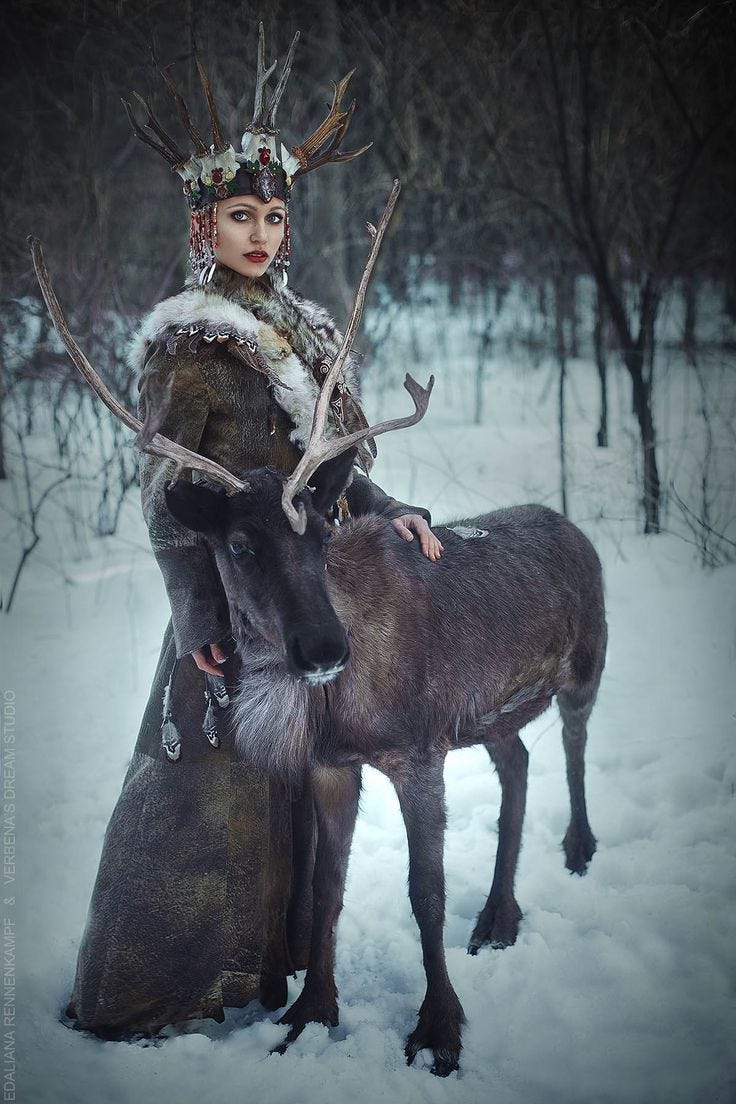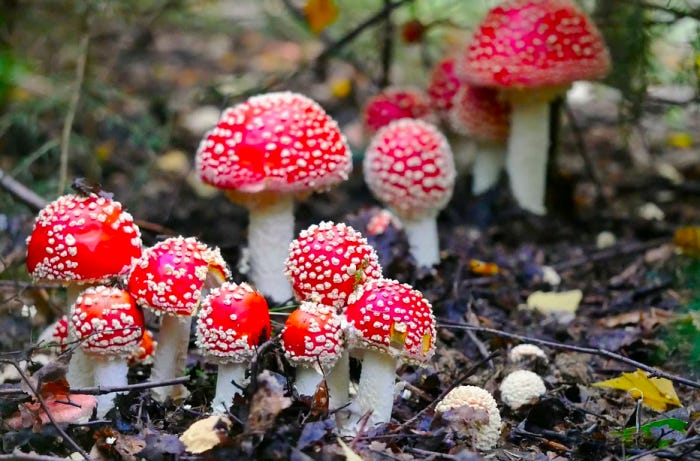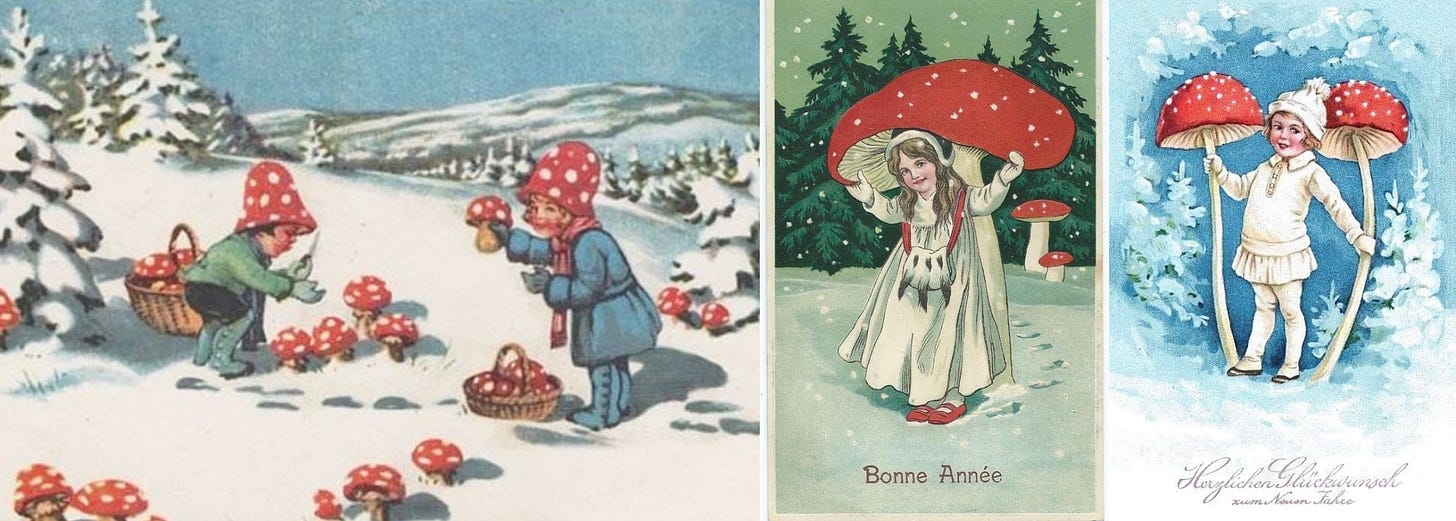
The concept of “Santa” may have been based on goddess myths — and all her reindeer, female.
The fabled figure of Santa Claus may have been inspired, at least in part, by the folklore of nomadic tribes across the Eurasian Steppe, including the British Isles, Scandinavia, Russia, Siberia, Mongolia, and the land bridge of the Bering Strait. Nomadic tribes revered various goddess figures associated with fertility, motherhood, regeneration and the rebirth of the sun — the central theme of Winter Solstice.
Since prehistory, the Winter Solstice has been a significant time of year in many cultures, and has been celebrated with festivals and rituals. It marked the symbolic death and rebirth of the Sun.
Ever since the early Neolithic, when the earth was colder and reindeer were more widespread, the female reindeer in particular was venerated by northern people. They depended on reindeer for their survival and followed reindeer migrations for milk, food, clothing and shelter. Male reindeer shed their antlers in winter, while female reindeer keep their horns.
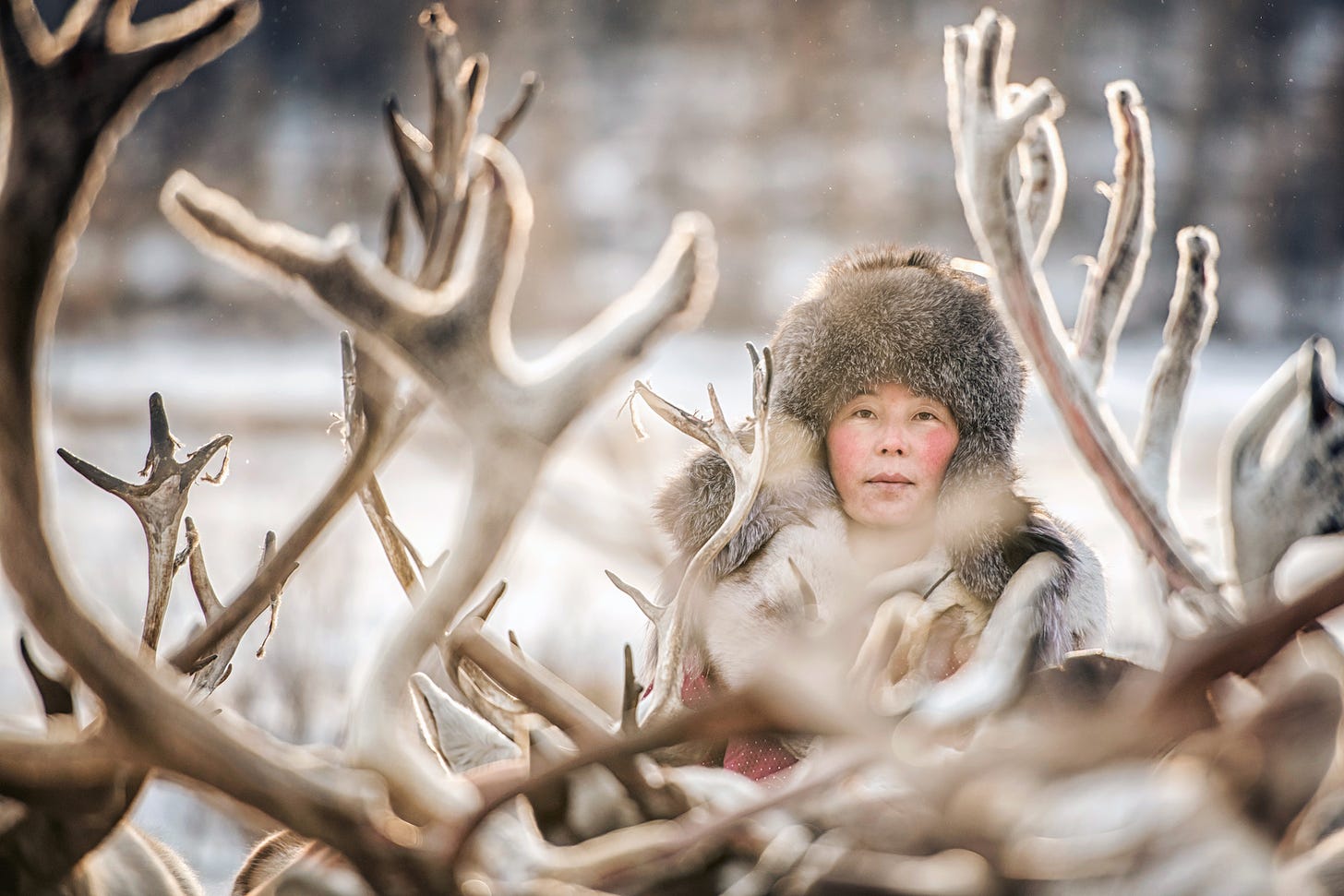
According to feminist researcher Judith Shaw, the night of Winter Solstice — the longest night of the year — was called the “Mother Night” and symbolized the regeneration of life. In her blog post titled, “The Reindeer Goddess”, Shaw describes several female figures who were depicted in ancient folklore.
Saulė, the Lithuanian and Latvian goddess of light and the sun, is the patron figure of orphans, and was mentioned in one of the earliest written sources on Lithuanian mythology. She was said to fly over the skies during Winter Solstice in a sleigh pulled by horned reindeer, dropping pebbles of amber, representing the return of the sun. In folksongs, the personified female Sun is associated with the colors red and white, as part of a description of the trajectory of the sun — red as it rises, white as it journeys on its way.

Beaivi, a sun goddess of the Sàmi, the indigenous people of the Nordic countries, was also said to fly through the heavens in a sled surrounded by reindeer antlers on the Winter Solstice with her daughter, Beaivi-nieida (sun maiden).
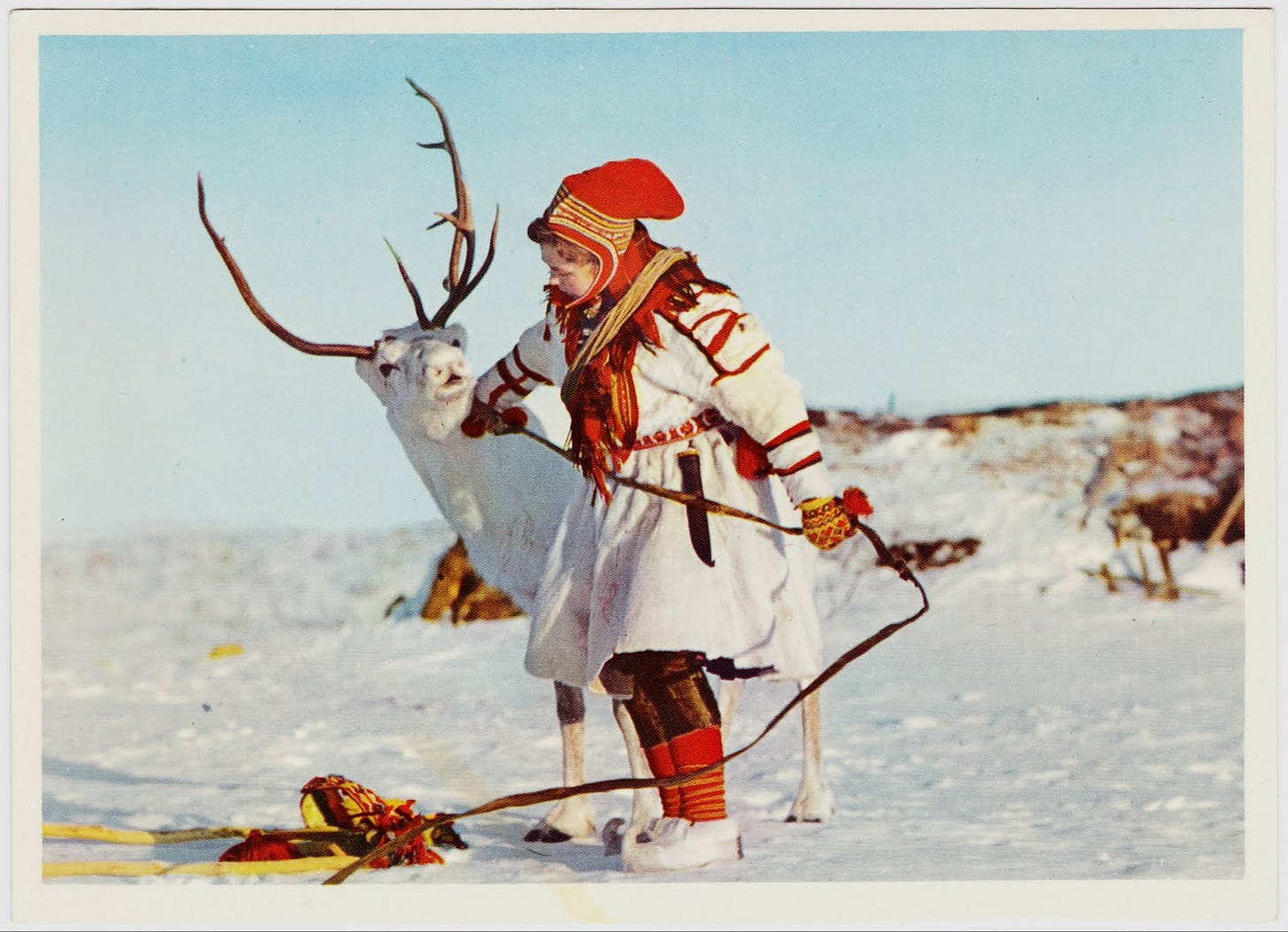
The Norse goddess Freyja or Frigga is a spinning goddess who sits at her wheel during the Winter Solstice, weaving the future fates of the year to come. The solstice celebration of Frigga was called Yule, from the Norse word for wheel. Even today, Christmas is often still called Yule or Yuletide, and the Christmas wreath was based on Frigga’s “Wheel of Fate.”
Rozhanitza, a horned goddess with reindeer antlers, is a Slavic goddess depicted in the embroideries of folk art, and her feast day occurs during Winter Solstice.
Horned goddesses can also be found in Celtic cultures. Elen of the Ways, also known as the Green Lady, was believed to be the guardian of roads, and she led nomadic people as they followed the migratory path of reindeer. She represented the journey from this world to the afterlife.
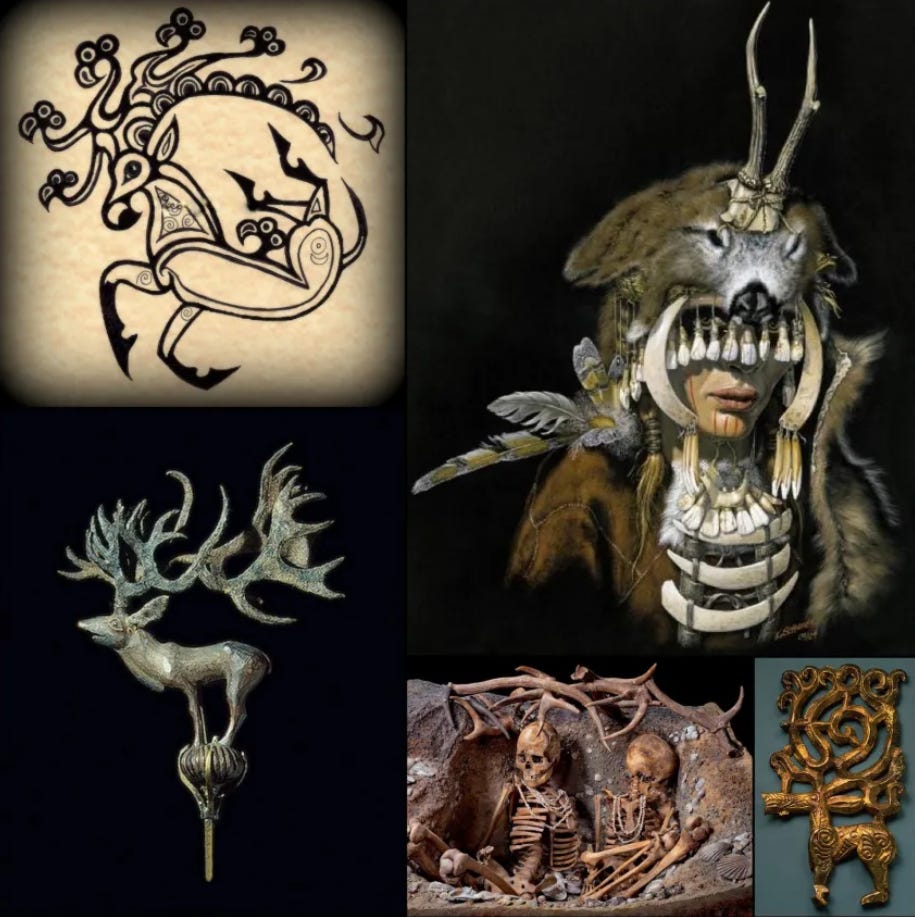
The Siberian Ice Maiden, also known as the Princess of Ukok or the Altai Princess, is a mummy of a Scytho-Siberian woman who lived on the Eurasian Steppes in the 5th century BC, found in 1993 in the Republic of Altai, Russia. Inside the Maiden's tomb chamber was her coffin, which was made of a solid larch wood tree trunk decorated with leather appliqués depicting deer figures.
The Ice Maiden's preserved skin has the mark of a leaping deer tattoo on one of her shoulders, and another on her wrist and thumb. She was buried in a yellow silk blouse, a crimson-and-white striped wool skirt with a tassel belt, thigh-high white felt leggings with fur, a small mirror made from polished metal and wood with carved deer figures, and a headdress that stood nearly three feet tall.
Esther Jacobson, author of The Deer Goddess of Ancient Siberia, explores the symbolism found in the art of the Scytho-Siberian world. The image of the deer occurs throughout the Eurasian Steppe and was a central symbol to the Early Nomads and their mythic traditions. Jacobson explores the meaning behind the deer's image from its probable first occurrence in the Neolithic in Siberia to the Iron Age. According to Jacobson, the deer image represented the Great Mother and her role in the cycle of death and rebirth.
“The image of the deer of the Early Nomads did not spring fresh and whole with the appearance of these people. It was rooted deep in the history of South Siberia, going back as far as the Neolithic period,” writes Jacobson.
“The shifting reference from deer to woman to deer, found in many archaic Siberian mythic traditions, is vividly reflected in the Nganasan belief in a swamp where their animal mothers live as naked women with the hair and antlers of deer. The great female elk, Kheglun, is said to carry the sun on its antlers.”
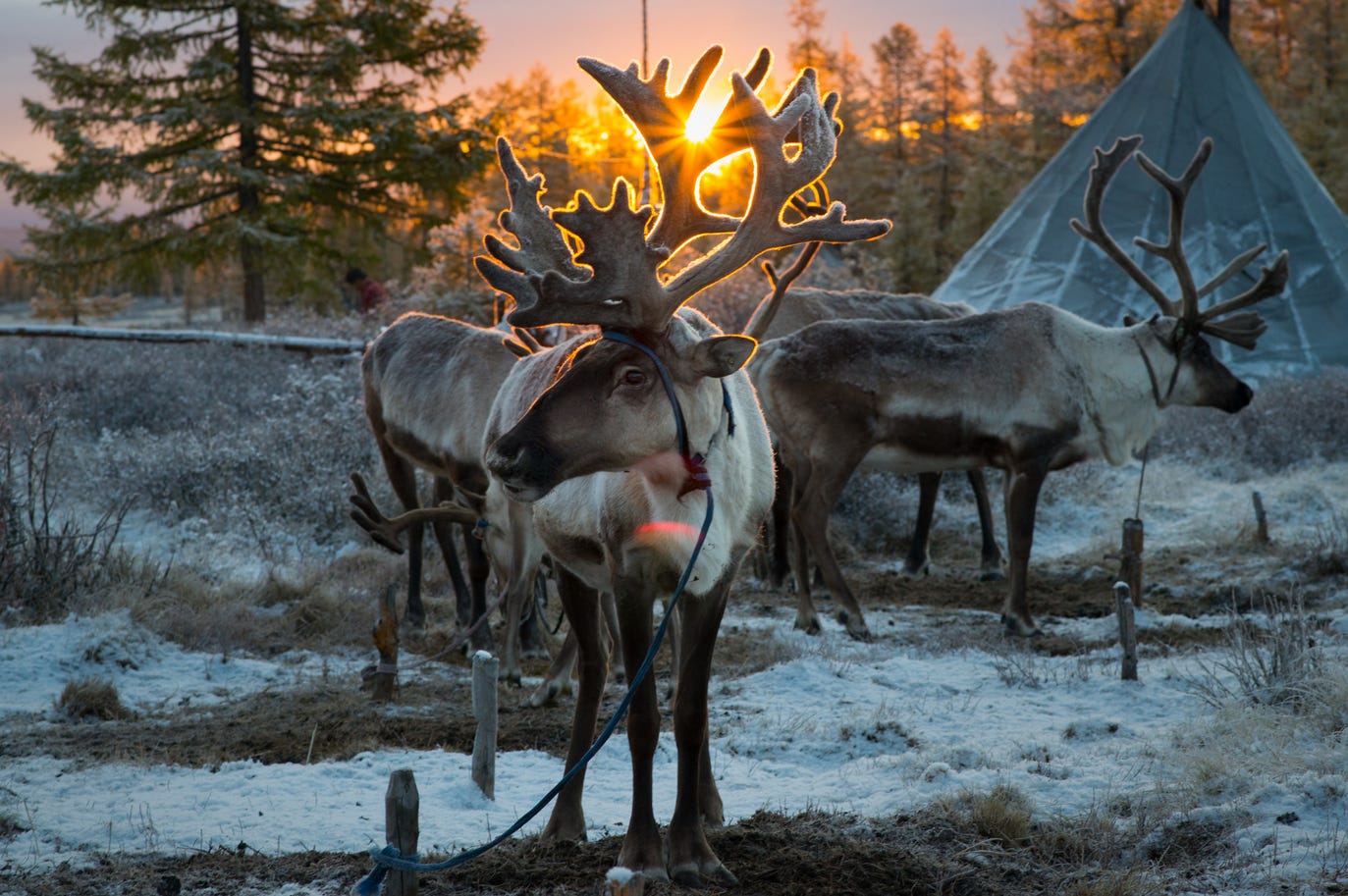
According to a blog post by Amusing Planet:
“Throughout the grasslands of northern Mongolia and southern Siberia lay scattered hundreds of megaliths bearing mysterious carvings that depict flying reindeer. Known as deer stones, these upright stone slabs measure 3 to 15 feet tall and occur in small groups, or concentrated in larger groupings, often in association with stone burial mounds, called khirigsuur. There are over 900 deer stones in Central Asia and South Siberia, of which 700 are in Mongolia alone. These monumental features is believed to be erected by Bronze Age nomads, approximately 3000 years ago.
Reindeer and the sun is a very common association in Siberian shamanism. Tattoos on buried warriors contain deer tattoos, featuring antlers embellished with small birds' heads. This reindeer-sun-bird imagery perhaps symbolizes the shaman's spiritual transformation from the earth to the sky: the passage from earthly life to heavenly life.
As these deer images also appear in warrior tattoos, it is possible that reindeer were believed to offer protection from dangerous forces. Another theory is that the deer spirit served as a guide to assist the warrior soul to heaven.”

The colors red and white, associated with modern Christmas decor, are thought to be inspired by Siberian legends in which reindeer and shamanic leaders “took flight” after ingesting the hallucinogenic Amanita Muscaria (fly agaric) mushroom, the archetypal red toadstool with white spots.
Amanita has been used for thousands of years as a medicine and as part of ceremonies and rituals by people of the northern latitudes of the world. This fungus is found deep in the forest beneath conifers, where it forms symbiotic relationships with pines, firs, and spruces.
The epicenter of traditional Amanita use was Siberia. Some researchers regard Siberia as the heartland of shamanism. The word “shaman” — one who knows the spirits — comes from the language of the Evenk, a small Tungus-speaking group of hunters and reindeer herders. “Shaman” originally referred specifically to a Siberian spiritual practitioner, one who would have been familiar with the ritual use of Amanita.
Researchers have also documented its use by numerous cultures throughout Europe and Asia. During the migration across the Bering Straits, fly agaric entered Alaska along with the nomads, and spread out across the American continent.
Reindeer are known to seek out the “magic mushroom”. Shamanic tribes consumed the mushroom for its psychoactive properties in religious rituals. Some shamans reportedly drank the urine of intoxicated reindeer, thereby avoiding its more toxic effects.
Amanita Muscaria features prominently in many European Christmas cards and designs from the beginning of the 20th century. Various illustrations depict the mushroom where it would have originally grown — in rings under pine trees.
Amanita must go through a process called decarboxylation, where the active compounds are made available by drying. It has been claimed that the nomadic deer-herding people would fill their stockings with the amanita muscaria and hang them over the fireplaces in order to “decarb” the mushrooms. Alternatively, it has been suggested that mushrooms may be hung on trees to dry them, in a practice that has been imitated today by decorating a Christmas tree.
It is likely that the traditional wear of the shamans and reindeer herders of the north is the true inspiration for Santa’s costume. The shamans “flew” with the Deer Mother on hallucinogenic vision quests on the longest and darkest night of the year.
Folktales describe how shamans, dressed in red suits with white spots, would collect the mushrooms and then deliver them through chimneys as gifts on the Winter Solstice.

The horned kichka or kichko is a headdress worn by female shamans in Siberia.
According to a post by Slavic Folklore & World Dreaming:
“The Horned Kichko in particular of all the Slavic and Russian headdresses have nothing to do with weddings, wives or marriages, regardless of what blogs and/or university trained archaeological or costume specialists say or teach. These very ancient horned headdresses were from previous pagan cultures and of the very ancient or primeval grandmother shamanic cultures. During the last few centuries, rather than lose the origins of this shamanic past of the horned kichko, the women would integrate their headdresses into modern ceremonies (such as weddings) as a way to keep the original horned headdress alive. Today, everyone calls all outfits of our sacred past as women a ‘wedding outfit,’ but this is not the whole truth, and is especially not true of the Horned Kichko. The Horned Kichko is [a] primal headdress of the shamanic past.”
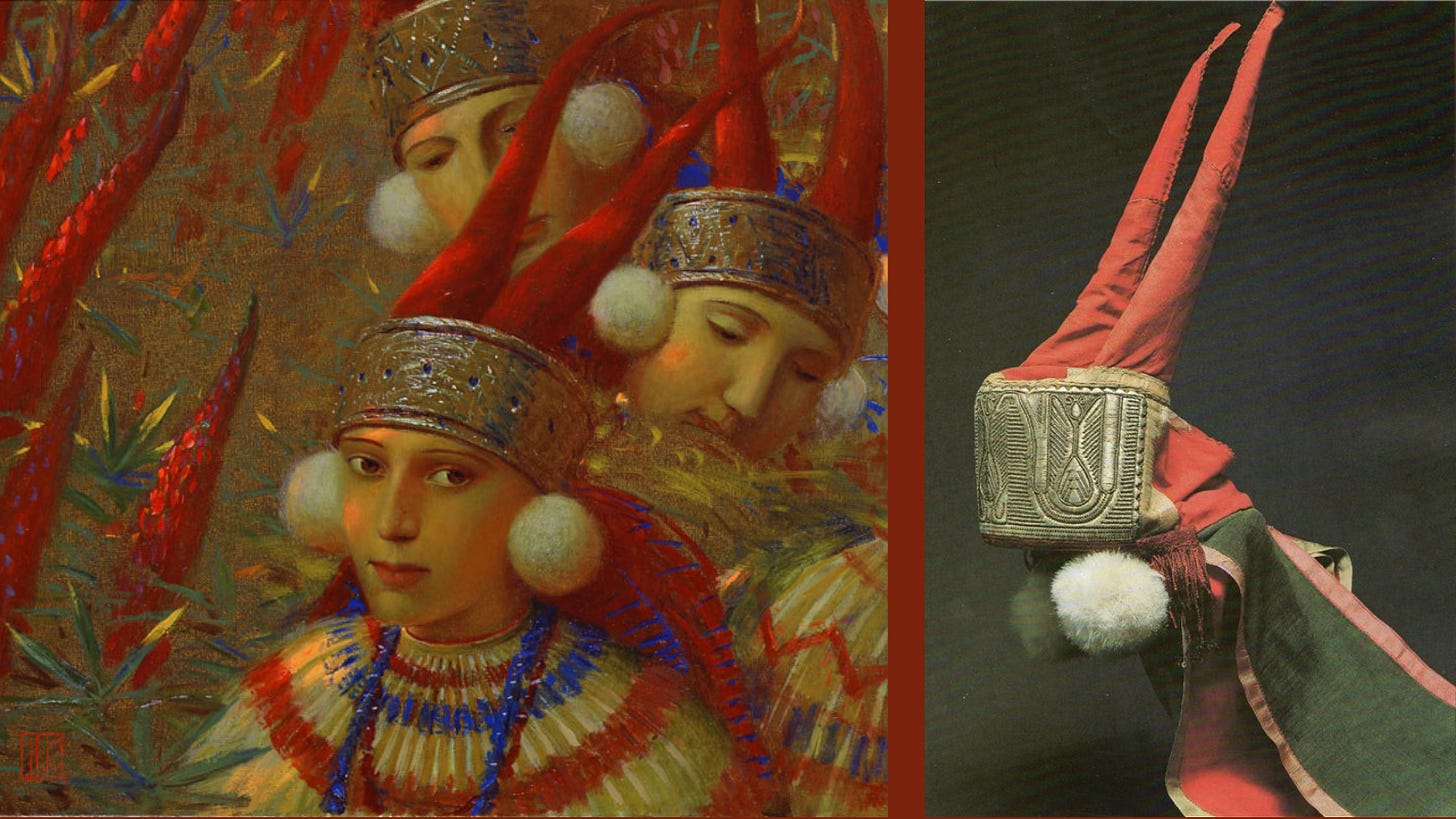
Sandy Krolick, PhD, shares his experience of living with shamans in Siberia with the following description:
“The shaman was a specialist in ecstatic trance. It is believed that the shaman’s soul was able to leave the body and travel to other parts of the cosmos, particularly to an upper world in the sky and to a lower world underground. While the shaman had different tools to assist in achieving trance — herbs, drumming, chanting, and dancing — the techniques of ecstasy came to reside solely with him or her. In the final analysis, the shaman’s role was to restore balance in a world that was apparently going off track.”

Gorgeous footage of reindeer herders in Northern Mongolia, near Khovsgol Lake. Despite only being able to spend three days in the Tsaatan family’s camp, photographer Joel Santos travelled for four days to reach them — three driving and one on horseback — before repeating the journey to return home. Travelling with an interpreter and a fellow photographer from Mörön, Mongolia, he met the Ganbaa family, led by matriarch Purev who lives with Buyantogtokh, a widowed reindeer herder.




